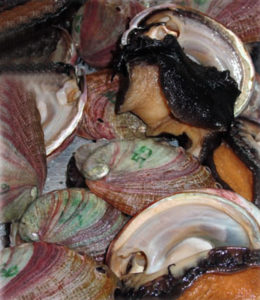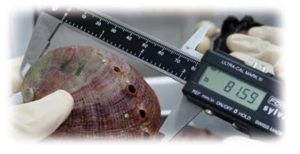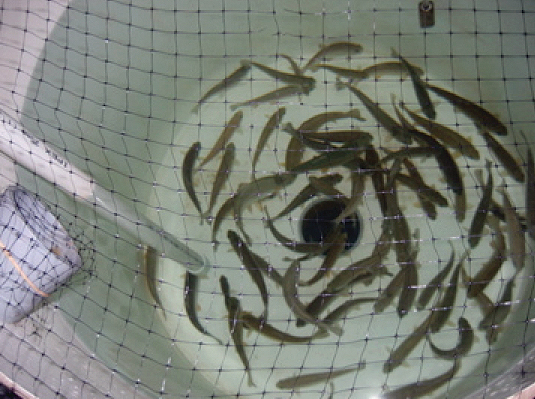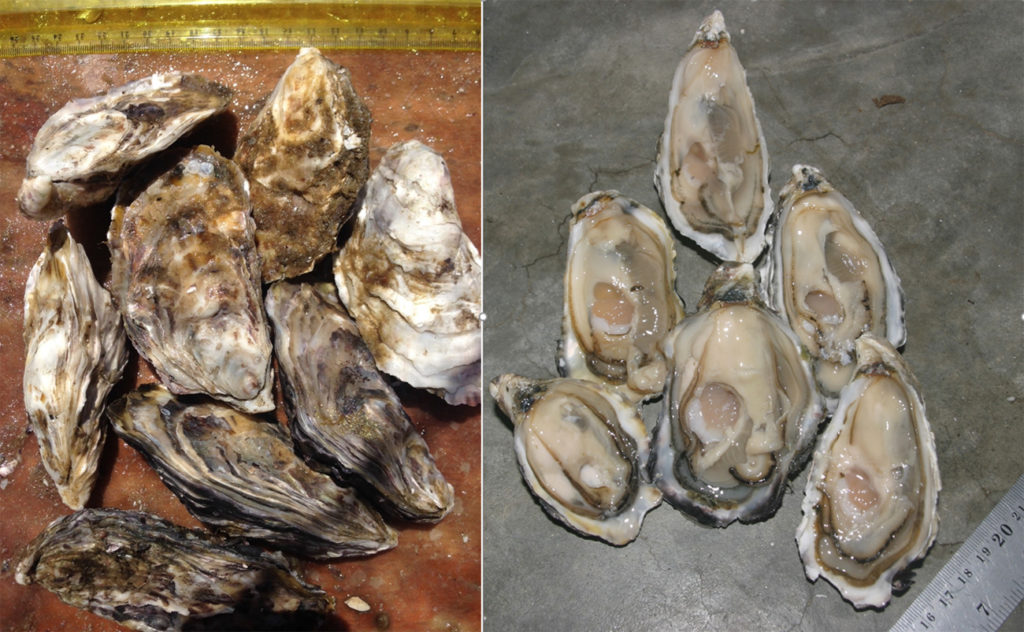Implications for breeding programs

In Mexico, it takes three to four years of culture for an abalone to reach market size of 80-cm shell length and 80-gram total weight. Commercial breeding and selection programs that seek to reduce this grow-out time must consider exploiting the biological potential of the species, including whether abalone morphology changes as abalone grow. The use of allometry has been of great value in understanding the way animal shape changes during growth in many species.
Allometry
Allometry is the study of size and its implications. Within a species, individuals differ in such features as body size, age at first reproduction, and the effort they put into growth and reproduction. When two variables in an organism increase proportionally, they are considered isometric, but when the increase in one of the variables is smaller (negative) or higher (positive) than the other, they are allometric. To determine whether a pair of variables is isometric or allometric, the allometric equation Y = a Xb is used, where X and Y are size-related measures, and a and b are empirical constants.
To determine whether a two-variable relationship – like shell length and width, for example – is isometric or allometric, it is necessary to test the value of b and find out whether it agrees with the theoretical isometric value: a) one for linear vs. linear units (cm vs. cm) or b) three for volume vs. linear units (g vs. cm).
Abalone morphology study
At two commercial abalone farms in Baja California, Mexico, the authors determined morphological relationships in red abalone (Haliotis rufescens) that ranged 12.0 to 84.4 cm in shell length. All variables were plotted against shell length and constants A and B were statistically tested to determine the isometric per allometric relationships between the variables and shell length. The animals’ sex (male, female, or undifferentiated) was noted to determine the size at which abalones matured. Table 1 shows the allometric equation parameter estimates determined.
del Rio-Portilla, Allometric equation parameter estimation against shell length for red abalones, Table 1
| Width | Height | Meat Weight | Shell Weight | Total Weight |
|---|
Width | Height | Meat Weight | Shell Weight | Total Weight | |
|---|---|---|---|---|---|
| Abulones Cultivados Farm | |||||
| n | 65 | 65 | 65 | 65 | 65 |
| a | 0.7015 | ||||
| b | 1.0056 | ||||
| r2 | 0.9847 | ||||
| Isometric | - Allometric | Isometric | - Allometric | - Allometric | |
| Productores Marinos Baja Farm | |||||
| n | 52 | 52 | 52 | 52 | 52 |
| a | 0.7193 | 0.4379 | 0.0001 | 0.0001 | 0.0002 |
| b | 0.9913 | 0.7889 | 3.0482 | 2.7868 | 2.9286 |
| r2 | 0.9918 | 0.9744 | 0.9909 | 0.9947 | 0.9948 |
Growing conditions, including the quality and quantity of available food, affect abalone growth and meat content. Under the good growing conditions at the farms, meat weight was isometric.
Practical implications

Natural negative allometry in red abalone shell length could be useful for abalone growers, because abalones may have a heavier shell when small that then becomes lighter as the animals grow, thus increasing meat yield. This also represents an advantage for abalone handling, because small abalones are proportionally less sensitive to handling than larger abalones.
Because it is not possible to measure abalone meat weight without sacrificing the animals, the authors suggested, based on the study, that red abalone breeding programs should use either family-sibling selection to estimate meat weight, or consider those abalones with a total weight higher than the expected value obtained with the equation Total Weight = 0.0002 Shell Length2.947. This equation was obtained when abalones from both farms were pooled together. The authors also found no difference in shape and trend among undifferentiated male and female abalones, which is the case in other gastropods.
Size at maturity
Another consideration for abalone-breeding programs is size at maturity. Red abalones mature at a relatively small size of 50- to 55-mm shell length and 20- to 25-gram total weight, while commercial size is around 80-mm shell length. This has important implications for abalone culture, because growth rates decrease when maturity is reached. Therefore, abalone-breeding programs should also consider size at first maturity for breeder selection.
The use of triploids has been proposed as an alternative for abalone production, because triploid animals, in general, do not use energy in gamete production and thus have more energy for growth. It would, however, be necessary to determine whether the weight per shell length relationship for these animals remains isometric or allometric.
Outlook
Due to high abalone fecundity, it is a common hatchery practice to use small numbers of broodstock. However, any abalone selective-breeding program should consider a large number of families. Thus, more studies on heritability and correlation between traits need to be carried out. The authors believe red abalone-breeding programs need to consider total weight rather than shell length when broodstock animals are selected, because of their allometric characteristics.
(Editor’s Note: This article was originally published in the November/December 2007 print edition of the Global Aquaculture Advocate.)
Now that you've reached the end of the article ...
… please consider supporting GSA’s mission to advance responsible seafood practices through education, advocacy and third-party assurances. The Advocate aims to document the evolution of responsible seafood practices and share the expansive knowledge of our vast network of contributors.
By becoming a Global Seafood Alliance member, you’re ensuring that all of the pre-competitive work we do through member benefits, resources and events can continue. Individual membership costs just $50 a year.
Not a GSA member? Join us.
Authors
-
Miguel Á. del Río-Portilla
Laboratorio de Genética
Departamento de Acuicultura
CICESE
Km 107 Carretera Tijuana-Ensenada
Ensenada, Baja California, Mexico 22800 -
Alberto Miranda-Velasco
Laboratorio de Genética
Departamento de Acuicultura
CICESE
Km 107 Carretera Tijuana-Ensenada
Ensenada, Baja California, Mexico 22800
Related Posts

Health & Welfare
Algae shows promise as alternative DHA source in rainbow trout diets
A growth trial in Canada evaluated the use of algae biomass to increase the concentration of long-chain polyunsaturated fatty acids in the tissues of rainbow trout.

Intelligence
An emerging shellfish farming industry in Namibia
For shellfish farming in Namibia to continue expanding, industry must better comply with approved sanitation standards. The Namibian Shellfish Monitoring and Sanitation Program, currently in development, will help.

Innovation & Investment
Aquaculture Exchange: George S. Lockwood
With his book, “Aquaculture: Will it Rise to Its Potential to Feed the World?” hot off the presses, the pioneer abalone farmer vents on U.S. aquaculture regulations but remains deeply optimistic about fish farming.

Aquafeeds
Aquaculture Exchange: Giovanni Turchini, Deakin University, part 1
One of the world’s leading fish nutrition experts talks about how aquaculture can learn to survive, and even thrive without depending on fishmeal and fish oil. It’ll take a lot of innovation, but Giovanni Turchini is confident that the industry is on the right path.


